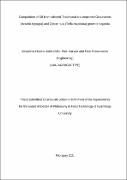Composition of Oil from selected Traditional and improved Groundnuts (Arachis hypogea) and Oyster nuts (Telfairia pedata) grown in Uganda
Abstract
Groundnuts and oyster nuts are important sources of edible oil, protein and micronutrients. Chemical composition of these nuts is affected by genetic and environmental factors as well as thermal treatment. The study determined chemical composition and oxidative stability of oil from groundnuts and oyster nuts grown in Uganda. Six traditional groundnut cultivars; Acholi white, Igola, Egoromoit, Rudu red, Rudu white, Red beauty and 14 improved cultivars; Serenut 1 to 14 were examined. Serenut cultivars were obtained from the National Semi-Arid Research Resources Institute in Serere District, Uganda while local cultivars were obtained from Soroti and Katakwi Districts in Eastern Uganda. Oyster nuts were obtained from three districts; Dokolo in North, Luwero in Central and Kamuli in Eastern Uganda. Oil from raw samples and heat treated nuts was analysed for fatty acid (FA) composition. Oil from raw nuts was analysed for antioxidant vitamins, minerals and tannins. Fatty acids were determined by Gas Chromatography-Mass Spectrometry with a Flame Ionisation Detector. Iodine value and lipid health indices were calculated from FA composition data. Vitamin A and E were analysed by High Performance Liquid Chromatography, beta-carotene and tannins by Visual Spectrometry while minerals by Atomic Absorption Spectrometry. All assays were done in triplicate. Analysis of variance was used to determine differences in composition was done using SPSS version 23. Traditional and improved groundnut cultivars had high oil yield ranging from 26.63 to 54.60%. Significant variability (p<0.05) was detected in oil yield among all cultivars. Oyster nuts yielded 45.32 to 56.14% oil. Acid value, peroxide value and iodine value of raw groundnut and oyster nut oil were within the recommended levels. Peroxide value of oil from stewed nuts was within recommendations. Raw groundnut oil contained 39.83 to 55.89% oleic, 20.23 to 35.59% linoleic and 11.90 to 17.17% palmitic acid as the major FA. Oil from Acholi white had high level of saturated and polyunsaturated FA compared to other cultivars. Raw oyster nut oil contained 41.50 to 44.87% linoleic, 33.58 and 38.75% palmitic and 9.48 to 13.65% stearic acid. Oleic, alpha linolenic, gamma linolenic and eicosenoic acid occurred in trace amounts. Polyunsaturated to saturated FA ratios were greater than the minimum level; 0.45 established by FAO/WHO. Omega-6 to ω3 ratio was beyond the recommended level of 4:1. Atherogenic and thrombogenic indices were <1 while hypocholesterolemic to hypercholesterolemic index was >1. Iodine decreased while peroxide value increased significantly (p<0.05) during processing. There was only slight modification (<10%) of the fatty acids composition during heat treatment and roasting at 179.3°C for 15min mostly caused decrease in polyunsaturated fatty acids. Stewing at 92oC for 15min appeared to be the better processing method for cooking of groundnuts and oyster nuts regarding conservation of linoleic acid and stability to oxidation. Vitamin A content of oil varied from not detected to 559 μg Retinol Activity Equivalents (RAE)/100 g. The highest level was detected in oil from Acholi white while none was detected in Igola, Rudu red and Red beauty; all traditional cultivars. Vitamin A in oil from improved cultivars ranged from 1.02 to 208.8 μg RAE/100 g in oil from Serenut 4Tan and 9Tan, respectively. Beta-carotene in oil ranged from 0.21 mg/100 g in Egoromoit to 1.72 mg/100 g in Rudu red while α-tocopherol ranged from 0.88 mg/100 g in Acholi white to 7.19 mg/100 g Serenut 13 Tan. Vitamin A in oyster nut oil ranged from 23.84 to 29.17 μg RAE/100 g. Oil from Kamuli nuts had the highest yield and nuts from Dokolo had the lowest. Beta-carotene in oil ranged from 2.65 to 3.69 mg/ 100 g. Nuts from Kamuli had the highest levels. Vitamin E (α-tocopherol) in oil ranged from 1.03 to 1.77 mg/100 g. The highest level of vitamin E was found in nuts from Dokolo. Calcium content ranged from, 0.05 to 3.41 mg/100 g; magnesium from 0.66 to 3.49 mg/100 g, iron from 0.02 to 0.35 mg/100 g and 0.05 to 0.55 mg/100 g zinc. Calcium content was low in traditional cultivars and the reverse was true for magnesium in comparison to improved cultivars. Iron and zinc occurred in trace.

